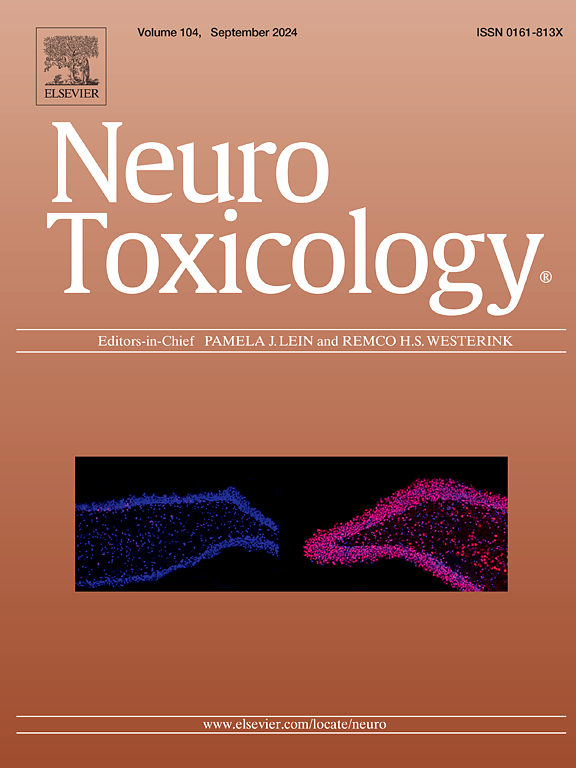A peripheral irritant motor response (PIMR) assay to identify chemical-induced locomotor deficits in larval zebrafish (Danio rerio)
IF 3.9
3区 医学
Q2 NEUROSCIENCES
引用次数: 0
Abstract
Zebrafish (Danio rerio) behavioral assays provide valuable insights into the effects of environmental chemicals on the developing nervous system, primarily through motor responses triggered by stimuli-induced CNS activation. However, as these responses rely on the locomotor integrity of larval zebrafish, chemical-induced impairments to their locomotor capacity could obscure behavioral observations and confound findings concerning the developmental neurotoxicity of the tested chemicals. This limitation emphasizes the need for supporting assays designed to specifically evaluate the locomotor capacity of larval zebrafish. In the present study, we evaluated the use of peripheral irritant-elicited motor responses as a method to identify chemical-induced locomotor deficits. The motor activity of 120 hours post-fertilization (hpf) zebrafish larvae exposed to different concentrations of two peripheral stimulants—mustard oil and cinnamon oil—was evaluated. Subsequently, we assessed changes to central (visual and acoustic) and peripheral (irritant) motor responses after tricaine-s (MS-222; neurodepressant) and tubocurarine (neuromuscular blocker) exposures. Additional investigations were also carried out to assess the central and peripheral motor activity of larvae after developmental exposures (114 h) to lead (Pb) and cadmium (Cd)—two suggested developmental neurotoxic environmental contaminants. Our observations revealed that exposure to mustard oil (12.5 µM) elicits the strongest motor response. Larvae exposed to MS-222 showed decreases in motor responses to visual and acoustic stimuli, but the same exposure induced limited effects on motor responses elicited by the peripheral irritant. Exposure to tubocurarine depressed all motor responses examined. Finally, both Pb and Cd exposures induced hypoactivation of central motor responses, but only Cd showed a significant depression in the peripheral irritant motor response (PIMR) in both intact and developmentally deformed larvae. This finding suggests that loss of locomotor capacity might be confounding the behavioral observations associated with Cd exposures. This research underscores the utility of this zebrafish-based PIMR assay in elucidating locomotor impairments induced by chemicals, which may obscure the behavioral findings of motor response assays designed to evaluate developmental neurotoxicity.
外周刺激性运动反应(PIMR)测定鉴定化学诱导的斑马鱼幼体运动缺陷
斑马鱼(Danio rerio)行为分析主要通过刺激诱导的中枢神经系统激活引发的运动反应,为环境化学物质对发育中的神经系统的影响提供了有价值的见解。然而,由于这些反应依赖于斑马鱼幼虫的运动完整性,化学物质引起的运动能力损伤可能会模糊行为观察结果,并混淆有关被测化学物质的发育神经毒性的发现。这一限制强调了需要专门评估斑马鱼幼虫运动能力的辅助试验。在本研究中,我们评估了使用外周刺激物引发的运动反应作为识别化学诱导的运动缺陷的方法。研究了受精后120 小时的斑马鱼幼体暴露于不同浓度的两种外周兴奋剂——芥菜油和肉桂油后的运动活性。随后,我们评估了tricaine-s (MS-222)后中枢(视觉和听觉)和外周(刺激性)运动反应的变化;神经抑制剂)和管柯碱(神经肌肉阻滞剂)暴露。此外,还开展了进一步的调查,以评估发育暴露于铅(Pb)和镉(Cd)(两种可能的发育神经毒性环境污染物)(114 h)后幼虫的中枢和外周运动活动。我们的观察显示,暴露于芥菜油(12.5 µM)会引起最强的运动反应。暴露于MS-222的幼虫对视觉和听觉刺激的运动反应均有所下降,但同样暴露对外周刺激引起的运动反应的影响有限。经检查,暴露于管碱抑制了所有运动反应。最后,Pb和Cd暴露均引起中央运动反应的低激活,但只有Cd对完整和发育畸形幼虫的外周刺激运动反应(PIMR)有显著抑制。这一发现表明,运动能力的丧失可能混淆了与Cd暴露相关的行为观察。这项研究强调了基于斑马鱼的PIMR分析在阐明化学物质引起的运动损伤方面的效用,这可能掩盖了旨在评估发育神经毒性的运动反应分析的行为发现。
本文章由计算机程序翻译,如有差异,请以英文原文为准。
求助全文
约1分钟内获得全文
求助全文
来源期刊

Neurotoxicology
医学-毒理学
CiteScore
6.80
自引率
5.90%
发文量
161
审稿时长
70 days
期刊介绍:
NeuroToxicology specializes in publishing the best peer-reviewed original research papers dealing with the effects of toxic substances on the nervous system of humans and experimental animals of all ages. The Journal emphasizes papers dealing with the neurotoxic effects of environmentally significant chemical hazards, manufactured drugs and naturally occurring compounds.
 求助内容:
求助内容: 应助结果提醒方式:
应助结果提醒方式:


